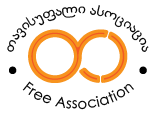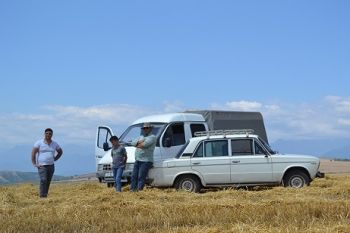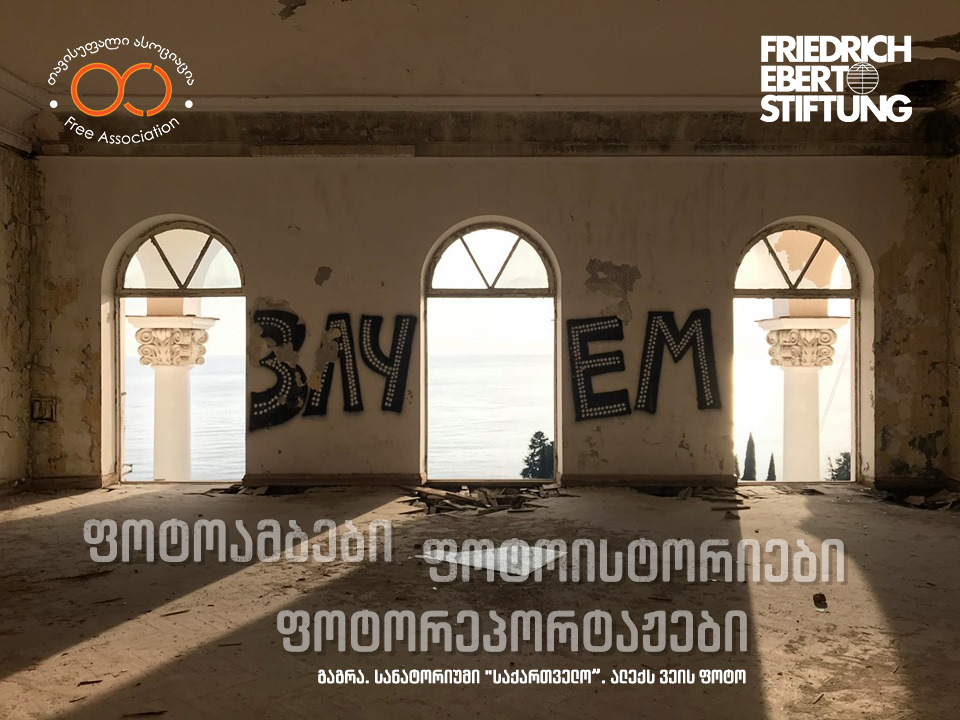93 წლის ვასილი კოზლოვცევი ხუმრობს, რომ მაშინ როცა ჯერ კიდევ კოლმეურნეობა არ არსებობდა, ის უკვე ცხოვრობდა. კოლმეურნეობაში სხვადასხვა სამუშაოს შემსრულებელ, ადგილობრივ უხუცესს დაარსების დღეც ახსოვს: "როდესაც მამაჩემი გადასახადების გადაუხდელობის გამო დააპატიმრეს, 7 წლის ვიყავი, და მეურნეობა ძალებს მაშინ იკრებდა, როცა ცალკეული ფერმერები საკუთარ ნაკვეთს უვლიდნენ და ასუფთავებდნენ. შემდეგ ვიყიდეთ რამდენიმე კომბაინი, ტექნიკის შემკეთებელი სახელოსნო გავხსენით.
ოდესღაც, საბჭოთა დროს, ნიკოლა ნიკიტინის სახელობის ძლევამოსილმა კოლმეურნეობამ აზერბაიჯანის 1996 წლს მიწის რეფორმა გადაიტანა, როდესაც კერძო პირებს გადაეცათ. გადაიტანა იმიტომ, რომ ივანოვკას მაცხოვრებლებმა ქვეყნის იმდროინდელ მმართველებს მიმართეს, რომ კოლმეურნეობა არ დაეშალათ. შედეგად ჰეიდარ ალიევმა განკარგულება "სახელმწიფო აქტი მიწის კოლმეურნეების მიერ სამუდამო გამოყენებაზე" გამოსცა და დაუწერელი კანონი: "თუ კოლმეურნეობა დაიშლება, მიწებს სახელმწიფო წაიღებს". ივანოვკა აზერბაიჯანის ისმაილინის რაიონის ცენტრიდან 15 კილომეტრში მდებარეობს, რომელსაც ექვემდებარება კიდეც.

მთავარი ადმინისტრაციული შენობა, ადგილობრივი წარმომადგენლობაა, მთელი თავისი გარე და შიდა იერსახით თითქოს საბჭოთა დროში გვაბრუნებს. აქ კოლმეურნეობის ხელმძღვანელობა, ადგილობრივი მუნიციპალიტეტი და რაიონის აღმასრულებელი ხელისუფლებაა განთავსებული.
სოფელში 2500-მდე ადამიანი ცხოვრობს, რომელთაგან ნახევარზე მეტი მალაკნები არიან, დანარჩენი აზერბაიჯანელები და ლეზგინები. სოფლისა და მისი მაცხოვრებლების ბედი კოლმეურნეობასთან პირდაპირ არის დაკავშირებული, 1998-2007 წლებში კრიზისი გადაიტანა, რაც 2015 წელს გაღრმავდა. შედეგად მოსახლეობა ივანოვკას ტოვებდა, განსაკუთრებით ახალგაზრდები. სოფელში გავლისას ახალგაზრდა მალაკნებს ნაკლებად შენიშნავთ. ისინი რუსეთში სასწავლებლად მიდიან და იქვე რჩებიან, ან საცხოვრებლად ბაქოში გადადიან. თუმცა, სოფლის ცენტრში ცოტა ხნის წინ საბავშვო ბაღი ააშენეს, ასევე, მოსასვენებელი პარკი, კულტურის სასახლე, ყველა აღიარებს, რომ ახალგაზრდებისთვის აქ გასართობი არაა. სოფელში ასაკოვანი მალაკნები და ახალჩასახლებული ადამიანები ცხოვრობენ. ვიღაც ბიზნესით არის დაკავებული, ვიღაცას კი პირადი მეურნეობა აქვს და ყველს, ხაჭოს, ღვინოსა და მწნილს ყიდის. მაგალითად, 1 კგ ყველი 3.5 ევრო ღირს, ხაჭო - 3 ევრო.
კოლმეურნეობაში სეზონური სამუშაოების მიხედვით 600-მდე ადამიანია დასაქმებული. შემორჩენილი ახალგაზრდები სასოფლო-სამეურნეო ტექნიკაზე მუშაობენ, ავტოფარეხებითა და მევენახეობით კი ასაკოვანი მაცხოვრებლები არიან დაკავებულნი. კოლმეურნეობის სიამაყე - ეს არის თესლის გამწმენდი და დამხარისხებელი ქარხანა, რომელიც ექსპლუატაციაში 2 წლის წინ შევიდა. საწარმოო სიმძლავრე 5000 ტონა თესლი საათშია, აქვე არის სასწორი 60 ტონის ტევადობით თესლის ასაწონად და ოთხი ლიფტი: ორი - 1000-ტონიანი, ორი - 500-ტონიანი.
63 წლის მარია ივანოვამ მთელი ცხოვრება ივანოვკაში გაატარა, ის ქარხანაში ქერს ასუფთავებს. მშობლიურ კოლმეურნეობაში სხვადასხვა დროს მან ფერმაში, ინკუბატორსა და მუშათა ჯგუფში იმუშავა: "ყველაზე რთულ დღეებშიც კი კოლმეურნეობის დატოვებაზე არ მიფიქრია, არც ივანოვკის. რუსეთში არ წავალთ, აქ მომწონს".
მარიას ორივე ქალიშვილი აქ მუშაობს. მიუხედავად იმისა, რომ მარია თვეში 165 ევროს იღებს, რაც ქვეყანაში მინიმალური ხელფასის ოდენობაა, პროდუქტებზე, ბრინჯსა და შაქარზე ხარჯავს. ყველაფერი დანარჩენი საკუთარი მეურნეობით აქვს. "გვყავს პირუტყვი, ღორები და ქათმები. ამის გარეშე ცხოვრება შეუძლებელია,"-გვარწმუნებს ის. ხელფასის გარდა კოლმეურნეობის წევრები დამატებით 4 კილოგრამ ქერსა და ხორბალს იღებენ, ასევე, 100 გრამ მზესუმზირის ზეთს ყოველ გამომუშავებულ მანათზე.
ამის გარდა, კოლმეურნეობის თანამშრომელი თუ კვდება, მის ოჯახს დაკრძალვაში ეხმარებიან ტრანსპორტითა და სასახლის შესყიდვით, ასევე, პურსა და 50 კილოგრამ ხორცსაც აძლევენ. კოლმეურნეობას 500-მდე პირუტყვი ჰყავს, რაც 3-4-ჯერ ნაკლებია 20 წლის წინანდელ რაონდეობაზე და 700-მდე ფრინველი. ძირითადი კულტურები, რომლებსაც მისდევენ: მზესუმზირა (250 ჰექტარზე), ბარდა (92 ჰექტარზე) და მევენახეობაა (210 ჰექტარზე).
კოლმეურნეობის მთავარი ქონება 5100 ჰექტარი სახნავი მიწაა, საიდანაც 4500-ზე ქერსა და ხორბალს თანაბრად თესავენ. გასულ წელს 191 ტონა მზესუმზირა მოიყვანეს, რაც მთავარია 3.3 ტონა ხორბალი. "ამ წელს მოსავლიანობა უკეთესი იქნება, 5.5 ტონას ვაპირებთ,"-ამბობს დეიანეტ რიზვანოვი, 47 წლის ბრიგადირი.
ეთნიკური აზერბაიჯანელი და სოფლის მცხოვრები, დეიანეტი - ყარაბაღის პირველი ომის ვეტერანი. ივანოვკაში ყარაბაღის ორი ომის მონაწილე თანასოფლელების ხსოვნას დიდ პატივს მიაგებენ.
დეიანეტი 1100 ჰექტარზე, მიწების მეოთხედზე, მოყვანილ მოსავალზეა პასუხისმგებელი. 10-წლიანი გამოცდილების ბრიგადირს ორი ვაჟი ჰყავს, უფროსი 16 წლის არის, უმცროსი - 11 წლის. უფროსი სასოფლო-სამეურნეო ტექნიკით მოსავლის აღებაში ეხმარება, უმცროსი კი მამასთან ერთად მეთვალყურეობს, სწავლობს. კითხვაზე, სად ისურვებდა ცხოვრებას, სოფელში თუ ბაქოში, გვპასუხობს, რომ ორივეგან.
მამა წინააღმდეგი არ არის, როცა ბავშვები წამოიზრდებიან, სოფელს თუ მიატოვებენ. მისი თქმით, რადგან სოფლის მეურნეობა მძიმე სამუშაოა, ახალგაზრდები ადგილზე დარჩენას არ გეგმავენ. "ყველაფერი რთულია: ხვნა, თესვა, მორწყვა, განაყოფიერება, დასუფთავება. ფიზიკურად ძალიან ბევრს შრომობ,"-ასევე, ამბობს, რომ სოფლის მეურნეობას სახელმწიფო სუბსიდიის გარეშე ზარალი აქვს.
კოლმეურნეობას სახელის მოხვეჭასა და წარმატებამდე ბევრი უკლია. თუმცა, ეს დროის ამბავია და ძალისხმევის საკითხი მათთვის, ვინც კოლმეურნეობაშია დასაქმებული და ვინც სოფელს არ ტოვებს, მიუხედავად არსებული გარემოებებისა და ეთნიკური და რელიგიური კუთვნილებისა.
In about 200 kilometers northwest of Baku, there is a very interesting village with no less interesting inhabitants – The Molokans. They are followers of one of the directions of the Russian Orthodox Church, which was formed as a result of the church reform in the 17th century. The Molokans appeared in Azerbaijan as early as the 19th century, and were distinguished from the local Muslim population by their lifestyle. Even in the 21st century, Ivanovka differs from other villages of Azerbaijan. There still is the only collective farm in the country.
93-year-old Vasiliy Kozlovtsev jokes that he lived here even before there were no collective farms. The local elder, who currently performs various jobs in the collective farm, remembers the day of its foundation: "When my father was arrested for not paying taxes, I was 7 years old, and the farm gathered strength when individual farmers were taking care of their lands. Then we bought several harvesters, opened a repair workshop.
During the Soviet era, a powerful collective farm named after Nikola Nikitin endured Azerbaijan's 1996 land reform, when it was transferred to private individuals. It was endured because the residents of Ivanovka appealed to the rulers of the country at that time not to dismantle the collective farm. As a result, Heydar Aliyev issued the decree "State Act on Perpetual Use of Land by Collective Farmers" and an unwritten law: "If the collective farm collapses, the state will take the land." Ivanovka is located 15 kilometers from the center of Ismailin district of Azerbaijan, to which it is subordinated.
The main administrative building, the local administrative office, with all its external and internal appearance seems to bring one back to Soviet times. The management of the collective farm, the local municipality and the executive authority of the district are all located here.
About 2,500 people live in the village, more than half of whom are Molokans, the rest are Azerbaijanis and Lezgins. The fate of the village and its inhabitants is directly related to the collective farm. It was difficult in 1998-2007 when the farm endured a crisis, which deepened in 2015. As a result, the population was leaving Ivanovka, especially young people. When passing through the village, one will rarely notice young Molokans. They go to study in Russia and stay there, or they move to Baku. However, a kindergarten was recently built in the center of the village, as well as a recreation park and a palace of culture. In spite of this, everyone admits that there is no entertainment for young people here. Elderly Molokans and newly settled people live in the village. Someone is engaged in business, and someone has a private farm and sells cheese, cottage cheese, wine and pickles. For example, 1 kg of cheese costs 3.5 euros, cottage cheese - 3 euros.
About 600 people are employed in the collective farm. But the work depends on the seasons. Older adults work on agricultural machinery, and elderly residents are busy with garages and viticulture. The pride of the collective farm is the seed cleaning and sorting plant, which was put into operation 2 years ago. The capacity of the enterprise is 5000 tons of seeds per hour, there is a scale for weighing seeds with a capacity of 60 tons and four elevators: two with the capacity of 1000-tons, two - 500-tons.
63-year-old Maria Ivanova spent her whole life in Ivanovka, she sorts out barley at the factory. At various times in her native collective farm, she worked in an incubator, then in a group of workers: "Even in the most difficult days, I have not thought about leaving the collective farm, nor Ivanovka. We will not go to Russia, I like it here."
Maria`s two daughters also work here. Although Maria receives 165 euros per month, which is the minimum wage in the country, she spends it on products, rice and sugar. All the rest she has on her own farm. "We have cattle, pigs and chickens. It is impossible to live without it,"- she says.
In addition to the salary, members of the collective farm receive an additional 4 kilograms of barley and wheat, as well as 100 grams of sunflower oil for every Manat they earn.
In addition, if a collective farm employee dies, his family is helped in the funeral by means of transport and the purchase of a palace, as well as the family receives bread and 50 kilograms of meat. The collective farm has about 500 cattle, which is 3-4 times less than 20 years ago, and about 700 poultry. The main cultures they follow are sunflower (250 hectares), peas (92 hectares) and viticulture (210 hectares).
The main property of the collective farm is 5,100 hectares of arable land, of which 4,500 hectares are planted equally with barley and wheat. Last year, 191 tons of sunflowers were brought and what is most important 3.3 tons of wheat. "This year the yield will be better, we are going to 5.5tones," says Dayanet Rizvanov, a 47-year-old supervisor.
An ethnic Azerbaijani local resident, Dayanet is a veteran of the First Karabakh War. In Ivanovka, the memory of fellow villagers who participated in two Karabakh wars is greatly honored.
Dayanet is responsible for the crops grown on 1,100 hectares, a quarter of the land. He has two sons, the elder is 16 years old, the younger - 11 years old. The elder helps in harvesting with agricultural machinery, while the younger.
The older one helps in harvesting with agricultural equipment, while the younger one supervises with his father and studies the work. When asked where he would like to live, in the village or in Baku, he answers that both.
The father does not mind if the children leave the village when they grow up. According to him, since agriculture is hard work, young people do not plan to stay in the place. "Everything is difficult: plowing, sowing, watering, fertilizing, cleaning. You work very hard physically," he says and adds that agriculture has serious losses if there are no state subsidies.
The collective farm has a long way to go before it becomes famous and successful. However, it is a matter of time and effort for those who are employed in collective farming and who do not leave the village, regardless of existing circumstances and ethnic and religious affiliation.



















